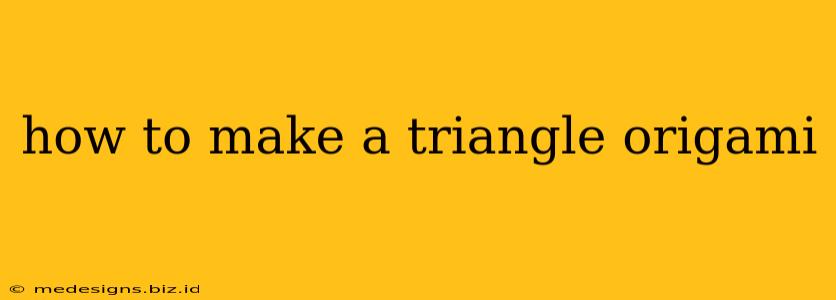Origami, the ancient Japanese art of paper folding, is a fantastic way to unleash your creativity and create beautiful, intricate designs. While some origami projects can be quite complex, starting with a simple triangle is the perfect introduction to this fascinating hobby. This guide will walk you through the basic steps, making it easy for even absolute beginners to master this fundamental shape.
Getting Started: What You'll Need
Before you begin your origami journey, gather these essential supplies:
- A square piece of paper: The size doesn't matter too much for a simple triangle, but larger squares are easier to work with for beginners. You can use origami paper specifically designed for folding (available in various colors and patterns), or even cut a square from regular printer paper.
- A flat, clean surface: A table or desk will provide a stable working area, allowing you to manipulate the paper easily.
Step-by-Step Instructions: Making Your First Origami Triangle
Step 1: Start with a Square
Begin with your square piece of paper lying flat in front of you, with one side facing upwards.
Step 2: Fold in Half
Fold the paper in half diagonally, bringing one corner to meet the opposite corner. Crease the fold sharply to make a clear line. Then, unfold the paper back to its original square shape. This first fold creates a reference line, vital for accurate folding in the next steps.
Step 3: Fold a Second Diagonal
Now fold the paper in half again diagonally, using the opposite corners this time. Crease the fold firmly and unfold the paper again. You should now have two clearly defined diagonal creases forming an "X" shape across your square.
Step 4: Forming the Triangle
Take one corner of the square and fold it to the opposite corner, following one of the diagonal creases you made. Make sure the edges line up perfectly.
Step 5: Crease and Finish
Crease the fold sharply. You've now successfully created your origami triangle!
Tips for Success
-
Sharp Creases: Making crisp, clean creases is essential for creating a neat and well-defined origami triangle. Use your fingernail or a bone folder (a specialized tool for origami) to ensure sharp folds.
-
Patience: Origami requires patience and precision. Don't get discouraged if your first attempts aren't perfect. With practice, you'll quickly improve your technique.
-
Experiment with Paper: Try different types and colors of paper to see how they affect the final look of your triangle.
Beyond the Basic Triangle: Expanding Your Origami Skills
Once you've mastered the basic triangle, you can use it as a foundation for more complex origami projects. Many designs begin with this fundamental shape, allowing you to build upon your skills and create increasingly intricate models. Search online for "easy origami models" to find more inspiration and tutorials.
Frequently Asked Questions (FAQs)
Q: What type of paper is best for origami?
A: Origami paper is ideal, but you can also use regular printer paper or even construction paper, though thicker paper might be more challenging for beginners.
Q: Why are sharp creases important?
A: Sharp creases are crucial for creating clean folds and maintaining the structural integrity of your origami model.
Q: Where can I find more advanced origami instructions?
A: Numerous websites and books offer origami instructions for all skill levels. You can also find many video tutorials on YouTube.
By following these simple steps, you'll be well on your way to creating your own beautiful origami triangles and exploring the exciting world of paper folding. Happy folding!
